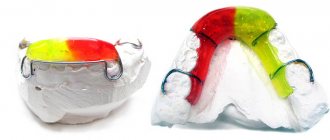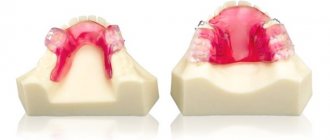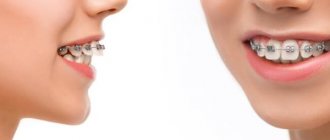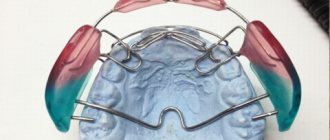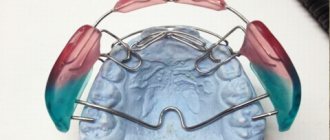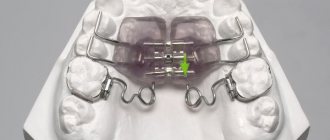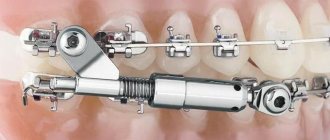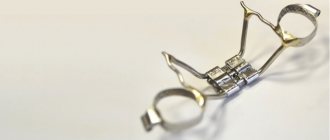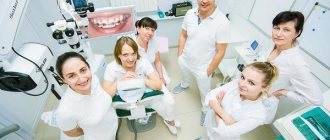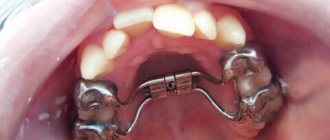4493
Most often, visits to the orthodontist are associated with malocclusion and crooked teeth. This anomaly occurs due to lack of space on the jaw joint during the growth of the front teeth.
Their location is highly compacted, as a result of which they are subject to axial rotation. To expand the jaw space and provide free space for new developing dental units, experts recommend the use of special devices.
Currently, the maxillary fixed apparatus Pendulum has gained popularity, which we will consider in detail in this article.
What is
When a child reaches school age, his bite begins to be mixed and then permanently formed. During this period, various pathologies of occlusion are possible, which can be easily eliminated using orthodontic appliances.
With their help, you can correct the shape of the jaw, accelerate the growth of certain parts of it, or, conversely, reduce the intensity of their development. In addition, such structures effectively change the position of crooked and incorrectly formed teeth.
The Pendulum device is made in the form of a plastic jaw plate. The product is formed according to an individual impression at a multifunctional dental enterprise for the production of dental and maxillofacial prostheses.
The plate is fixed on the teeth using special wire hooks and is easily removed from the oral cavity during meals and hygienic cleansing.
To straighten crooked bone organs, the removable structure is equipped with special elements, the work of which is aimed at exerting pressure on the dental unit. In this case, the generated force will have a given direction.
The patient quickly gets used to the effects of such structures and stops noticing the device after a few weeks of wearing it. Everything is explained by the ease of oral care and the presence of low pressure.
As a rule, the Pendulum apparatus is used in orthodontics to correct abnormal bites in children.
Innovative Alf technology in orthodontics
Many patients suffering from malocclusion experience changes in their facial sculpture. This leads not only to visible aesthetic defects, such as sagging skin, depressions along the cheekbones, and so on, but also to psychological discomfort, which can cause suffering to the patient and cause complex forms of depressive conditions.
Alf device in orthodontics, price
which makes it accessible to a fairly wide range of patients, is used primarily for correction of the facial skeleton. As a result of using the technique, all the bones of the skull gradually and non-traumatically move to the anatomically correct places for the patient. This allows you to change the shape and oval of the face, tighten sagging skin due to the formation of malocclusion and solve other aesthetic problems in orthodontics.
New generation braces are used as an auxiliary system during treatment, which help to form a correct bite and correct the position of all teeth in the dentition. Alf device in orthodontics, reviews
which is mostly positive, both from patients and from the best specialists in the field of orthodontics, allows you to get excellent results in a fairly short period of time. The cost of the device is largely individual; the final calculation can only be made to you by a specialist at your appointment. And the prices for braces are indicated in the “Orthodontics (bite correction)” block.
If you have experience correcting your bite using the above or other similar orthodontic devices, leave your review and express your opinion, and also receive a bonus - a 3% discount on any dental services.
Indications
Orthodontists use the Pendulum apparatus for mechanical correction of the dentition in the upper jaw in adolescence.
Indications for use include:
- correction of lateral dental units back;
- lack of space in certain areas of the dentition (crowding);
- expansion of the upper jaw structure;
- sagittal shape of the position of the upper dentition;
- correction of abnormal bite in children and adults;
- treatment of pathologies or complex use while wearing braces.
Design features of the Quadhelix device and its structure.
In this publication you will learn what Dilyar's face mask is.
Follow the link https://orto-info.ru/sistemyi-vyiravnivaniya-zubov/individualno-izgotovlennyie-apparatyi/tvin-blok.html if you are interested in reviews about the Twin Block device.
Medical Internet conferences
Scientific supervisor: Doctor of Medical Sciences, Professor G.V. Stepanov
Malocclusions are a common pathology among all dental diseases. One of the most common forms of dental anomalies is distal occlusion, which is detected in more than 70% of cases.
Distal occlusion is a violation of the closure of the upper and lower dentition, when the upper jaw predominates over the lower jaw.
The immediate cause of this pathology, as a rule, is a lack of space in the dental arch during the eruption of canines. Lack of space occurs under the influence of numerous factors, the main of which are shortening of the dental arch, which is formed as a result of early removal of primary molars and the lack of subsequent prosthetics, sagittal or transversal deformation of the dental arch.
If the closure of the upper and lower dentition is disrupted, the chewing load is incorrectly distributed. This is one of the significant factors in bone atrophy and gum recession (gum recession). Teeth lose support and become loose.
Distal occlusion leads to disruption of facial aesthetics: the upper lip protrudes forward, the supramental fold is pronounced, and the chin is often “sloping.”
The problem of treating distal occlusion remains relevant to this day due to the fairly high prevalence of this pathology. In addition, symptomatic treatment, the most optimal and effective in permanent dentition, is usually accompanied by a decrease in the number of teeth. In this case, quite often the first or second intact premolars are removed. In addition, symptomatic treatment is not ideal. Pathogenetic treatment is considered optimal. The development of various methods and means of this treatment aimed at normalizing the position of the lateral teeth is ongoing. Currently, quite a lot of different orthodontic structures (removable and fixed) have been proposed that solve the problem of distal movement of the lateral teeth of the upper jaw. It is worth noting that the use of orthodontic appliances is a rather lengthy process due to the seriousness of the intervention in the dental system and the body as a whole. When using the most common removable plate appliances, an oblique-rotational movement of the teeth occurs, which causes morphological and functional disorders in the lateral sections of the dentition, so the effectiveness of this group of devices is not high enough.
The inconvenience associated with wearing orthodontic appliances often leads to patient refusal of treatment. There is a need to use additional treatment methods to increase the effectiveness and reduce the time of orthodontic treatment.
When treating patients with distal occlusion, it is necessary to create conditions for the distal movement of the lateral teeth of the upper jaw and the oral movement of the teeth of the frontal group. There are a number of devices designed to solve this issue. For example, using a facebow with a cervical (head) traction, it is possible to move the second molars of the upper jaw on both sides distally, but this design is very bulky, not aesthetic and creates inconvenience for the patient.
Rice. 1. Face bow with cervical (head) traction
To expand the upper dentition in the transversal direction and to move the molars back, the Pendulum apparatus is used. This device is fixed on molars and premolars using bandage rings with tubes, lingual locks and a palatal base. Intraoral appliances require increased support for distalization of molars, which makes their design quite bulky and disrupts the patient’s speech function.
Rice. 2. Pendulum device
Sometimes, to achieve a positive effect, reinforcing screws are additionally introduced into the devices, as is done in the Pendulumplus device. This device is used to expand the dentition of the upper jaw in the transversal direction and distalize the molars. Pendulumplus differs from Pendulum in the presence of a Hyrex screw. The Hyrex screw is located in the center of the palatal base and is the activated part of the device.
Rice. 2.1. Pendulumplus device
The DistalJet palatal device is also known, the main purpose of which is to distalize the lateral group of teeth in the upper jaw. The main elements of the device are: lingual tubes, palatal clasp, bayonets and guide tubes, Nance device (Nance button).
Rice. 3. DistalJet device
Often, together with the palatal elements in the apparatus for distalizing molars, distalizing screws are used, located vestibularly, as in the Firstclass apparatus.
Rice. 4. Firstclass device
There are also special Frog screws that are used to move molars distally.
Rice. 5. Frog device
All of these already existing devices have both advantages and a number of disadvantages, consisting mainly of bulkiness, long treatment times and unaesthetics, which served as the reason for the creation of a new device.
The proposed device for moving a permanent molar consists of orthodontic crowns, which are individually manufactured by stamping (laboratory stage) and an expanding screw.
Rice. 6. Apparatus for moving the permanent maxillary molar
Orthodontic crowns are placed on the first and second premolars and the first and second molars of the upper jaw. Orthodontic crowns on the first and second premolars and the first molar are also soldered together to enhance support.
The expansion screw for distal movement is installed on the first and second molars on the vestibular side.
Soldering of the screw to stamped crowns is carried out with silver-palladium solder (laboratory stage). The guide rod of the screw is cut off in order to prevent trauma to the mucous membrane when the jaws move. Next in the laboratory the structure is bleached, grinded and polished.
The maximum expansion screw capacity is 9mm.
Rice. 7. View of the device at maximum expansion of the screw.
The movement mechanism is as follows. The active element - the screw - causes a force aimed at moving the maxillary molar distally. The screw is activated by operating the screw lock with a key. The key is placed in the hole of the screw lock and the screw is turned from top to bottom until pressure is felt. Turning the screw one turn provides an increase in the gap between the teeth by 0.1 mm, which is necessary for distalization of the molar.
Fig.8. Type of device in the oral cavity
After 1 month of using the device, the distance between the teeth is 2.5-4.5 mm.
The advantages of the proposed device are that the movement of the molar occurs due to the influence of a dosed load on the tooth. Design solutions allow for maximum comfort when wearing the device due to the absence of a palatal base. Strong fixation is ensured through the use of individually made stamped crowns. Corpus movement of teeth is achieved. When using this device, the aesthetic appearance and speech of patients is preserved.
Conclusion
A new device for distalization of a molar in the upper jaw, developed at the Department of Pediatric Dentistry of Samara State Medical University, increases the effectiveness of treatment for patients with distal occlusion, which allows reducing the time of orthodontic treatment.
Contraindications
In order to carry out a quality correction, you will need not only a competently trained orthodontist, but also a serious patient with excellent hygienic condition of the oral cavity.
Here it is important to constantly monitor carious processes and be prepared for a long period of treatment.
Contraindications to the use of orthodontic appliances include:
- frivolity of the patient's intentions;
- the presence of complex dental diseases in the oral cavity;
- multiple destruction of dental units;
- low qualification of the orthodontist;
- some forms of occlusion pathologies that cannot be corrected using this type of orthodontic appliances.
Orthodontic project "Dial-Dent"
In modern orthodontics, there are many treatment methods. All of them are aimed at creating a beautiful bite, but it is important to remember that orthodontic treatment alone is not enough to achieve long-term results. The presence of dental anomalies often indicates the presence of other problems in the patient’s body - adenoids, incorrect posture, psycho-emotional abnormalities, etc. The Dial-Dent clinic has implemented a new approach to the treatment of patients with orthodontic problems - the orthodontist project of O.A. Baranova. Only comprehensive treatment will relieve you of orthodontic problems forever!
Design features
The Pendulum device is presented to patients in different modifications, which is determined by the individual characteristics of a particular case.
The product is a non-removable metal structure that exerts a force on the teeth and consists of the following elements:
- the supporting part is a plastic plate that is in close contact with the front part of the palate;
- arch - puts pressure on the teeth;
- rings - used for fixation on molars and premolars of the upper jaw;
- hooks - fixation details;
- screws - serve to adjust the degree of expansion;
- springs are active elements.
In general, the plate is made in the form of a standard design with special clasps that are fixed to the teeth. The arc is passed through the fasteners and is tightened from time to time, exerting a certain pressure on the teeth.
The plate is formed from a soft plastic material, exactly repeating the shape and surface relief of the patient's palate. It is this that serves as a support for holding the metal arc for alignment.
The wire is made from titanium and nickel alloys , which have the effect of returning to the original shape. That is why, under any load, the metal arc will return to the specified shape.
Operating principle
The Pendulum device is a non-removable structure that must be worn continuously during the correction period. The base is two plastic plates that are connected to each other with a screw. A metal wire in the shape of an arc is attached to them. It is made from the alloying alloy TMA (Betaflex). To fix the metal arc to the teeth, rings located at the ends are used.
The doctor installs the device so that the plates are adjacent to the palate. Using an adjusting screw, he moves them apart to the desired position. The arch exerts a force on the chewing teeth, and as a result, the bone tissue of the upper jaw begins to expand. Correction takes 6-8 months.
At the next stage, you can begin to straighten the teeth in the smile area. For this, as a rule, braces are used. If the teeth are not very crooked, other orthodontic structures can be used for correction.
How it works
The plastic plate of the device rests on the sky. The loops of the product are fixed on the distant dental units of the chewing area. Using special hook-shaped fasteners, installation is carried out on permanent teeth located near the frontal zone.
The force generated by the arc is transferred to the teeth and gradually moves them in the desired direction . As a rule, the lateral bone organs move backward. This creates a free space, which allows you to correct the correct position of the front teeth of the upper jaw.
While wearing this orthodontic design, a greatly expanded interdental space may appear. This happens due to the appearance of excess space on the jaw.
However, the patient should not perceive such manifestations as a side effect of using the device. Subsequently, the deficiency can be eliminated with the help of braces, which can correct all defects in the dentition.
Kinds
During the period of mixed occlusion, any correction is aimed at using the hardware method. In rare cases, specialists resort to complex methods. The bite takes the correct position and shape due to the movement of bone organs and the correction of dental arches.
Functionally, the guide apparatus works not only due to the pressure of the arc on the teeth, but also due to the force of the masticatory muscles, which is transmitted to the dental units through special elements.
That is why Pendulum devices were created in several types, the action of which is aimed at solving certain problems.
With special spring and adjusting screw
The design is based on TMA wire springs, which are designed specifically for this type of structure. In conjunction with them, the work is performed by special Hyrex screws that regulate the degree of expansion.
The device is designed to simultaneously move the lateral group of molars back and expand the upper jaw system.
The use of a built-in spring and screws made using innovative technologies allows you to create a low force to achieve maximum physiological changes.
Nitinol springs can expand the palatal suture without discomfort in a short period of time. Thanks to this, the effectiveness of the correction is noticeable after a few weeks of treatment .
Manufacturing technique of the Ainsworth apparatus and its principle of operation.
Read here what the Nance device is designed for.
At this address https://orto-info.ru/sistemyi-vyiravnivaniya-zubov/kappyi-elayneryi/byinina.html you will learn about the stages of making Bynin’s mouth guard.
Without spring
This type of Pendulum device is equipped with two sectional screws and four special rings for the bandage.
The design has an enhanced impact and displaces dental units on both sides, exerting different pressure.
Others
Among other types of Pendulum devices, the following devices stand out:
- Classic model , equipped with special spring elements without a sectional screw. Fastening is carried out using rings located on the occlusal legs of the clasp.
- Pendex device . Has a special screw for Hilgers adjustment.
- Pendulum with a screw that adjusts the Kinzinger displacement.
- Bi-pendulum . Displaces the first molars on one side.
Advantages
Before using the Pendulum device, with the goal of expanding the dentition, extraction of dental units from the alveoli is not required .
After the plate moves the chewing teeth in the posterior direction, brackets are applied in the frontal zone, which will give the dentition a straight line and correct the bite.
The main advantages of the device include:
- possibility of three-dimensional fixation of dental units;
- convenient location of the structure, which makes it invisible (the plate is installed under the sky);
- easy device activation;
- Possibility of use in combination with other structures;
- high efficiency indicators and excellent final results;
- the ability to regulate pressure by pulling;
Main indications and contraindications for the use of the design
Specialists prescribe twin blocks to correct malocclusions (in particular, distal, mesial and open bites). Often, the help of the device is resorted to in the presence of the following problems:
- sagittal gap of teeth between the upper and lower jaws;
- pronounced overlap of one incisor with another;
- incorrect inclination of some molars (both on the upper and lower jaw);
- lack of contact of teeth with each other (especially those located in the central part).
The design should be used with particular caution if the patient suffers from gum pathologies or other dental diseases (in particular, periodontitis and gingivitis). In this case, the doctor first treats the affected area. The design is most effective in childhood and adolescence (up to 15 years). It is prescribed to adults extremely rarely, since the result will be weak or completely absent.
Wearing time and care
The design is worn constantly and removed only for eating and performing hygiene procedures.
After each removal, the device is washed under warm running water and dried with a paper towel. To facilitate the adjustment period, the plate is made of soft materials and has a thin thickness.
In the first days after installation, the patient will feel minor discomfort, since the plate is installed in the place where the tongue is permanently located.
In some cases, there is a violation of diction, the pronunciation of sounds is distorted. However, such effects disappear quickly , and the patient stops paying attention to the presence of the structure in the oral cavity.
As a rule, under the influence of the Pendulum device, teeth move by 3 mm in 30 days. The duration of treatment will depend entirely on the complexity of the anomaly.
After a thorough examination, the orthodontist determines the period of wearing the structure. On average, the device is used from 6 to 10 months.
Installation of the device
Before installing the device, the patient should undergo dental treatment, stop inflammatory processes in the oral cavity, and undergo a teeth cleaning procedure with special means. Installation of the structure takes place in several stages.
- Examination of the patient, identifying the cause of the pathology, studying dental anomalies.
- Choosing a system for bite correction.
- Preparing the surface of molars for installation.
- Taking an impression of the jaw.
- Making a device based on a cast.
- Trying on the manufactured device.
- Design adjustments.
- Final installation and fixation of the rings.
The result of treatment should be a correct bite, which will enable the jaw to function normally. After correcting the position of the molars using the Pendulum apparatus, uneven front teeth can be corrected with orthodontic braces. Depending on the complexity of the pathology and the degree of malocclusion, a combination of treatment methods is possible.
While wearing the device, you should be careful about the condition of your oral cavity. Regular hygiene procedures will help protect the oral cavity from the development of pathological processes: thorough brushing of teeth at least twice a day, flossing after meals, using mouth rinse and irrigator. It is equally important to follow all other recommendations of your orthodontist, who will monitor the progress of treatment.
Prices
The cost of all types of Pendulum devices will depend entirely on the pricing policy of the manufacturer of the structural elements and the prices for the services of orthodontic laboratories. Let's look at the average cost of popular device types:
- Pendulum (one jaw) - 7,000-8,000 rubles;
- Pendex - 16,500-17,500 rubles;
- Bi-pendulum - 10,000-11,000 rubles;
- Pendulum plus - 9,000-9,500 rubles.
The video shows the process of manufacturing and installing the Pendulum device.

